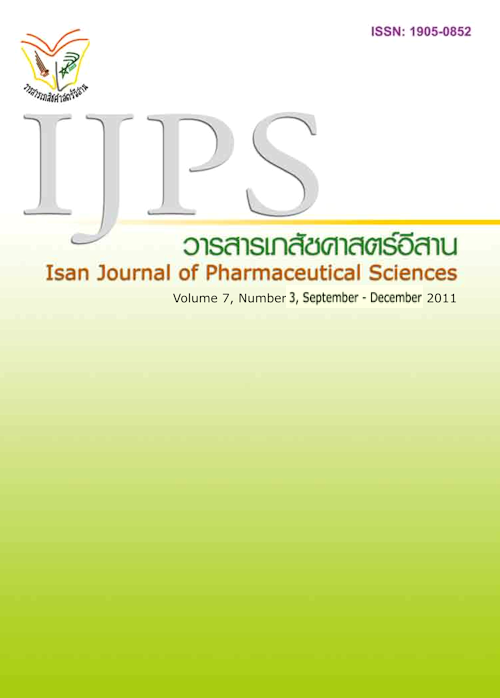Development of Modifed Extract and HPLC Analytical Method for Determination of Rutin in Modifed Extract of Longan seed
Main Article Content
Abstract
Introduction: Several studies of chemicals in longan (Dimocarpuslongan Lour.) seed have been suggested to have positive effect on defcit in learning and memory. In our study, the ethyl acetate extracts of longan seeds found the positive effect on learning and memory impairment after bilateral carotid arteries (2-VO) occlusion in mice. Materials and Methods: The Fractionation of the ethyl acetate part by conventional chromato-graphic technique together with the screening activities was performed. A HPLC-analytical method was developed for determination of rutin, a chemical marker in modifed extract using reverse phase column with isocratic elution. Hesperidin was used as an internal standard. Results: We obtained pure four major compounds with physical and spectroscopic data acquired indicated as quercetin, gallic acid, propyl gallate and rutin. Rutin showed to be a one of the most active principle compounds at dose 100mg/kg; we proposed rutin as chemical marker for the modifed herbal extract. The method was validated according to ICH guideline and showed linearity range of 0.31-1.54µg/ml of rutin (r2=0.9940). The percentage recovery (%R) was in the range of 99.30-101.98 and the relative standard deviation (%RSD) was not more than 2. The limit of detection and limit of quantifcation of rutin were 0.13 and 0.38 µg/ml, respectively. Conclusion: We prepared relatively stable herbal extract from longan seeds by removing the unstable phenolic portion for further chemical and preclinical studied. Also, High-performance liquid chromatogra-phy technique was used for quality control of modifed extract of longan seed. Proper validation of HPLC method according to ICH guidelines.
Article Details
In the case that some parts are used by others The author must Confirm that obtaining permission to use some of the original authors. And must attach evidence That the permission has been included
References
DharmanandaS. EMBLIC MYROBALANS: AMLA Key herb of Ayurvedic medicine [online]. 2003 Sep [cited 2011 Apr 13]. Available from:http://www.itmonline.org/arts/amla.htm
Hui YH, Barta J, Cano MP, et al. Tannins. Handbook of fruit and fruit processing. 2006; 400.
ICH Steering Committee. 2006. International Conference on Harmonization of Technical Requirements for the Registration of Pharmaceuticals for Human Use. Validation of analytical procedure.
Kishore K, Singh M. Rutin (a bioflavonoid antioxidant) attenuates age-ralated memory deficits in mice.Ind Medica 2005; 16(1):6-10.
Koda T, Kuroda Y, Imai H. Rutin supplementation in the diet has protective effects against toxicant-induced hippocampal injury by suppression of microglial activation and pro-inflammatorycytokines. Cell MolNeurobiol 2009; 29: 523-531.
Losuwannarak N, Pasadhika C, Tantisira M, et al.Effects of seed extract on scopolamine-induced learning and memory deficit in mice. Thai J. Pharm. Sci2009; 33: 31-38.
Lucas M S, Dias A A, Bezerra R M, et al. Gallic acidphotochemical oxidation as a model compound of winery wastewaters. J Environ Sci Health 2008; 43: 1288-1295.
Park S J, Park D H, Kim D H, et al. The memory-enhancing effects of Euphoria longan fruit extract in mice. J Ethnopharmacology 2010; 128: 160–165.
Pu F, Mishim K, Irie K, et al .Neuroprotective effects of quercetin and rutin on spatial memory impairment in an 8-Arm Radial Maze Task and neuronal death induced by repeated cerebral ischemia in rats. J Pharmacol science 2007;104:329-334.
Rangkadilok N, Sitthimonchai S, Worasuttayangkurn L, et al. Evaluation of free radical scavenging and antityrosinase activities of standardized longan fruit extract. Food Chem Toxicol 2007; 45:328-336.
Richetti SK, Blank M, Capiotti KM, et al.Quercetin and Rutin prevent scopolamine-induced memory impairment in zebrafish. Behav Brain Res 2011;217(1):10-15.
Wanakhachornkrai O. Effect of N-(2-Propylpentanoyl) urea on impairment of learning memory cell death after bilateral common carotid arteries occlusion in mice [Master’s degree of science program in physiology]. Bangkok: Chulalongkorn University; 2006.
Zheng G, Xu L, Wu P, et al. Polyphenols from longan seeds and their radical-scavenging activity. Food Chem 2009; 116: 433-436


